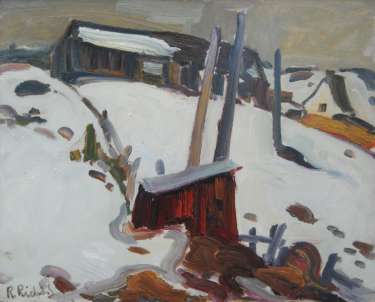
René Richard ARC / RCA
Painter René Richard was born on December 1, 1895, in La Chaux-de-Fonds (Switzerland) and died in Baie-Saint-Paul (Québec) on March 31, 1982. The son of an immigrant who settled in Cold Lake (Alberta) with all his family, he was attracted at an early age by the wide open spaces and the sense of freedom that they gave him. Therefore, at the age of 18, he became a ‘coureur des bois’(woodsman) for many years, learning trapping techniques the hard way. During this period of time, he did hundreds of pencil drawings which demonstrated his passion for the Nordic vastness and the daily life of the Aboriginals with whom he mingled regularly. In 1926, he took his first drawing classes in Edmonton (Alberta) and the following year, he left for Paris to perfect his artistic training at the Académie de la Grande-Chaumière. In the French capital, he met the Montreal painter, Clarence Gagnon, who became his mentor and friend. Upon his return to Canada in 1930, René Richard resumed his former woodsman’s life, this time bringing in his bags colour tubes, pencils and wrapping paper for canvasses. It was during this time that he found his true style, leaving behind the classicism that characterized his previous artworks. ‘’Quickly drawn on paper, the line runs, both soft and marked, encircling the trunk of a tree, lightening the curve of a cheek to resume speeding like a skater performing an extravagant ballet. The artist gives free rein to his fantasy, his imagination, and therefore, while being inspired by the subject, he transcends it, magnifies it.’’ (Hughes de Jouvancourt). In 1938, Clarence Gagnon brought his friend to Baie-Saint-Paul (Charlevoix), a village that he loved. Captivated by the beautiful surroundings, René Richard went back a few months later to settle there permanently and dedicate himself to his art full-time. And in 1942, he married Blanche Cimon, the daughter of the people who had hosted him right from his first visit. The following year, he held his first exhibition at the Art français which was a complete success. He sold all his paintings in less than two days. This led to being represented by three major art galleries: Klinkhoff Gallery in Montreal, the galerie Zanettin in Québec City and René Bergeron’s gallery in Chicoutimi. Later, thanks to his friendship with Gabrielle Roy and Mgr Félix-Antoine Savard, he illustrated their respective works, namely ‘’ La montagne secrète ‘’ (translated as The Hidden Mountain) in 1975, and a new edition of ‘’ Menaud, maître-draveur ‘’ (translated as both Boss of the River and Master of the River) in 1979.
In 1973, René Richard was decorated with the Order of Canada and in 1980, he was made a member of the Royal Canadian Academy of Arts. The same year, he donated a sizeable collection of his work to Laval University: paintings and sketches as well as a dozen drawings used to illustrate ‘’ Menaud, maître-draveur ‘’. Upon his death, he increased his bequest to the University by 131 paintings and drawings. There were numerous exhibitions dedicated to him both during his lifetime and posthumously, among which: at the Musée du Québec (now Musée national des beaux-arts du Québec) in 1967 and 1978, the City of Montreal (1986), the Villa Bagatelle, Québec City (1990), La Chaux-de-Fonds (Switzerland) (1992-1993), the Centre d’art de Baie-Saint-Paul (now Musée d’art contemporain de Baie-Saint-Paul) (1993) and Domaine Cataraqui, Québec City (1996).
‘’René Richard is without doubt one of the Canadian painters who best captured the North—its loneliness, rudimentary living conditions, and vast open spaces marked by the seasons. His prolific output stands as an impressive contribution to Canadian art: hundreds of works made up mostly of studies, drawings—a category that encompasses rough sketches, sanguine crayon, charcoal and pencil crayon as well as more detailed oil pochades and drawings in pencil crayon and felt pen—and small and large format oil paintings…Richard’s highly personal and somewhat expressionistic style conveys the struggle for human survival amidst the harsh northern environment of polar deserts, vast forests and rivers.’’ (Esther Pelletier, Professor, Laval University)
 Top of page
Top of page























